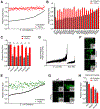A Delicate Balance between Bacterial Iron and Reactive Oxygen Species Supports Optimal C. elegans Development
- PMID: 31444089
- PMCID: PMC6742550
- DOI: 10.1016/j.chom.2019.07.010
A Delicate Balance between Bacterial Iron and Reactive Oxygen Species Supports Optimal C. elegans Development
Abstract
Iron is an essential micronutrient for all forms of life; low levels of iron cause human disease, while too much iron is toxic. Low iron levels induce reactive oxygen species (ROS) by disruption of the heme and iron-sulfur cluster-dependent electron transport chain (ETC). To identify bacterial metabolites that affect development, we screened the Keio Escherichia coli collection and uncovered 244 gene deletion mutants that slow Caenorhabditis elegans development. Several of these genes encode members of the ETC cytochrome bo oxidase complex, as well as iron importers. Surprisingly, either iron or anti-oxidant supplementation reversed the developmental delay. This suggests that low bacterial iron results in high bacterial ROS and vice versa, which causes oxidative stress in C. elegans that subsequently impairs mitochondrial function and delays development. Our data indicate that the bacterial diets of C. elegans provide precisely tailored amounts of iron to support proper development.
Keywords: C. elegans; E. coli; diet; electron transport chain; flux balance analysis; iron; metabolic network modeling; metabolism; reactive oxygen species.
Copyright © 2019 Elsevier Inc. All rights reserved.
Conflict of interest statement
DECLARATION OF INTERESTS
The authors declare no competing interests.
Figures







Similar articles
-
ROS-based lethality of Caenorhabditis elegans mitochondrial electron transport mutants grown on Escherichia coli siderophore iron release mutants.Proc Natl Acad Sci U S A. 2019 Oct 22;116(43):21651-21658. doi: 10.1073/pnas.1912628116. Epub 2019 Oct 7. Proc Natl Acad Sci U S A. 2019. PMID: 31591219 Free PMC article.
-
Metabolism in the Caenorhabditis elegans Mit mutants.Exp Gerontol. 2005 Nov;40(11):841-9. doi: 10.1016/j.exger.2005.06.015. Epub 2005 Aug 30. Exp Gerontol. 2005. PMID: 16137850 Review.
-
Mitochondrial electron transport is a key determinant of life span in Caenorhabditis elegans.Dev Cell. 2001 Nov;1(5):633-44. doi: 10.1016/s1534-5807(01)00071-5. Dev Cell. 2001. PMID: 11709184
-
Iron Wars - The Host Strikes Back.N Engl J Med. 2018 Nov 22;379(21):2078-2080. doi: 10.1056/NEJMcibr1811314. N Engl J Med. 2018. PMID: 30462940 No abstract available.
-
Effects of the mitochondrial respiratory chain on longevity in C. elegans.Exp Gerontol. 2014 Aug;56:245-55. doi: 10.1016/j.exger.2014.03.028. Epub 2014 Apr 5. Exp Gerontol. 2014. PMID: 24709342 Review.
Cited by
-
Bacterial diet modulates tamoxifen-induced death via host fatty acid metabolism.Nat Commun. 2022 Sep 23;13(1):5595. doi: 10.1038/s41467-022-33299-5. Nat Commun. 2022. PMID: 36151093 Free PMC article.
-
WormPaths: Caenorhabditis elegans metabolic pathway annotation and visualization.bioRxiv [Preprint]. 2020 Dec 23:2020.12.22.424026. doi: 10.1101/2020.12.22.424026. bioRxiv. 2020. Update in: Genetics. 2021 Aug 26;219(1):iyab089. doi: 10.1093/genetics/iyab089. PMID: 33398287 Free PMC article. Updated. Preprint.
-
Host-microbe interactions rewire metabolism in a C. elegans model of leucine breakdown deficiency.Nat Metab. 2024 Aug;6(8):1584-1600. doi: 10.1038/s42255-024-01098-5. Epub 2024 Aug 8. Nat Metab. 2024. PMID: 39117959 Free PMC article.
-
Gut microbial genetic variation modulates host lifespan, sleep, and motor performance.ISME J. 2023 Oct;17(10):1733-1740. doi: 10.1038/s41396-023-01478-x. Epub 2023 Aug 7. ISME J. 2023. PMID: 37550381 Free PMC article.
-
A bacterial pathogen induces developmental slowing by high reactive oxygen species and mitochondrial dysfunction in Caenorhabditis elegans.Cell Rep. 2023 Oct 31;42(10):113189. doi: 10.1016/j.celrep.2023.113189. Epub 2023 Oct 5. Cell Rep. 2023. PMID: 37801396 Free PMC article.
References
-
- Andrews NC (2000). Iron metabolism: iron deficiency and iron overload. Annu Rev Genomics Hum Genet 1, 75–98. - PubMed
-
- Andrews NC, and Schmidt PJ (2007). Iron homeostasis. Annu Rev Physiol 69, 69–85. - PubMed
-
- Banerjee R, and Ragsdale SW (2003). The many faces of vitamin B12: catalysis by cobalamin-dependent enzymes. Annu Rev Biochem 72, 209–247. - PubMed
MeSH terms
Substances
Grants and funding
LinkOut - more resources
Full Text Sources
Medical

